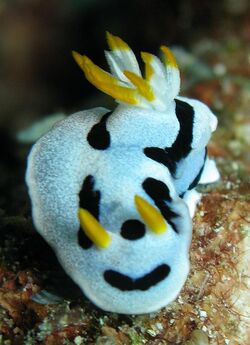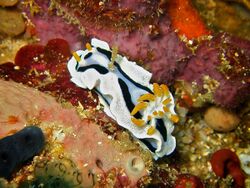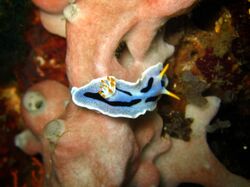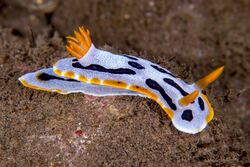Biology:Chromodoris dianae
| Chromodoris dianae | |
|---|---|

| |
| Chromodoris dianae | |

| |
| Chromodoris dianae from Verde Island, the Philippines | |
| Scientific classification | |
| Domain: | Eukaryota |
| Kingdom: | Animalia |
| Phylum: | Mollusca |
| Class: | Gastropoda |
| Subclass: | Heterobranchia |
| Order: | Nudibranchia |
| Suborder: | Doridina |
| Superfamily: | Doridoidea |
| Family: | Chromodorididae |
| Genus: | Chromodoris |
| Species: | C. dianae
|
| Binomial name | |
| Chromodoris dianae Gosliner & Behrens, 1998[1]
| |
Chromodoris dianae is a species of sea slug, a dorid nudibranch, a shell-less marine gastropod mollusc in the family Chromodorididae.[2]
Distribution
This species is known only from the Philippines , Indonesia and Borneo.[3]


Description
Chromodoris dianae can reach a maximum size of 4 cm length.[4] The body is elongate with a foot which is distinct from the upper body by a skirt like mantle partially hiding the foot. This species is very similar in appearance to Chromodoris lochi although it can be distinguished from the latter by the broken black lines, (as opposed to continuous) and the sprinkling of white specks on the notum.[5][6][7] Chromodoris dianae has white gills and rhinophores with distinct yellow-orange tips. The original description includes animals which belong to another species (Chromodoris cf. dianae) which are distinguished by a colour pattern which includes gills and rhinophores orange throughout, orange markings at the edge of the mantle and a different pattern of black markings; confirmed as species level differences by DNA sequences.[8][9][10]
Ecology
Chromodoris dianae, like many other nudibranchs, feeds on sponges. It has been reported to eat Cacospongia mycofijiensis and Petrosaspongia nigra, both in the family Thorectidae.[11]
References
- ↑ Gosliner, Terrence M.; Behrens, D.W. (1998). "Five new species of Chromodoris (Molluscs: Nudibranchia: Chromodorididae) from the tropical Indo-Pacific Ocean". Proceedings of the California Academy of Sciences. 4th series 50 (5): 139–165. https://www.biodiversitylibrary.org/page/15659747.
- ↑ "Chromodoris dianae Gosliner & Behrens, 1998". MolluscaBase. World Register of Marine Species. 2022. http://www.marinespecies.org/aphia.php?p=taxdetails&id=457494.
- ↑ Rudman, W.B., 1998 (April 8) Chromodoris dianae Gosliner & Behrens, 1998. [In] Sea Slug Forum. Australian Museum, Sydney.
- ↑ Christian Robilliart (19 August 2011) Chromodoris dianae. At Sous les Mers.
- ↑ P.L. Beesley, G.J.B. Ross, A. Wells, (1998) Mollusca - The southern synthesis, vol.5, CSIRO, 1998, ISBN:0-643-05756-0
- ↑ Behrens, D. W., 2005. Nudibranch behaviour, New World Publications Inc., ISBN:978-1878348418
- ↑ Gary Cobb & Richard Willan, Undersea jewels - a colour guide to nudibranchs, Australian Biological Resources Study, 2006, ISBN:0642568472
- ↑ Layton, Kara K.S.; Gosliner, Terrence M.; Wilson, Nerida G. (2018). "Flexible colour patterns obscure identification and mimicry in Indo-Pacific Chromodoris nudibranchs (Gastropoda: Chromodorididae)". Molecular Phylogenetics and Evolution 124: 27–36. doi:10.1016/j.ympev.2018.02.008. PMID 29476907.
- ↑ Rudman, W.B., 2001 (Jun 25). Comment on Variation? in Chromodoris dianae by Bernard Picton. [Message in] Sea Slug Forum. Australian Museum, Sydney.
- ↑ Gosliner, T.M., Behrens, D.W. & Valdés, Á., 2018. Nudibranch and Sea Slug Identification - Indo-Pacific. New World Publications; 2nd Revised, Updated edition. 452 pp. ISBN:1878348671, ISBN:978-1878348678, p. 137
- ↑ Rudman, W. B.; Bergquist, P. R. (2007). "A review of feeding specificity in the sponge-feeding Chromodorididae (Nudibranchia: Mollusca)". Molluscan Research 27 (2): 60–88. https://www.mapress.com/mr/content/v27/2007f/n2p088.htm.
External links
- Photos of Chromodoris dianae on Sealife Collection
Wikidata ☰ Q1424341 entry
 |

